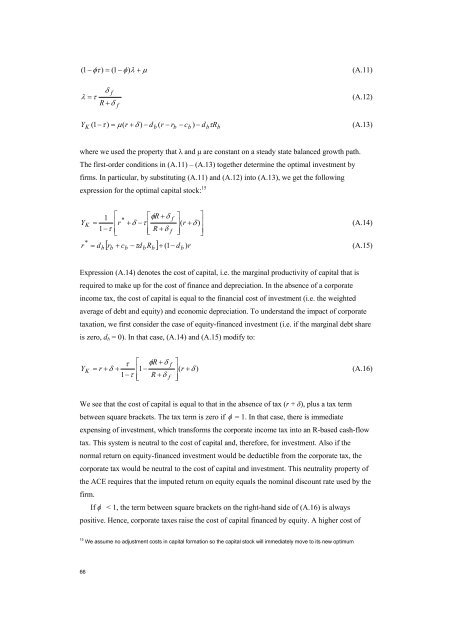The economic effects of EU-reforms in corporate income tax systems
The economic effects of EU-reforms in corporate income tax systems
The economic effects of EU-reforms in corporate income tax systems
You also want an ePaper? Increase the reach of your titles
YUMPU automatically turns print PDFs into web optimized ePapers that Google loves.
( 1− φτ ) = (1 −φ)<br />
λ + µ<br />
(A.11)<br />
δ f<br />
λ = τ<br />
(A.12)<br />
R + δ<br />
Y<br />
K<br />
f<br />
( 1− τ ) = µ ( r + δ ) − d r − r − c ) − d τR<br />
(A.13)<br />
b (<br />
b<br />
b<br />
b<br />
b<br />
where we used the property that λ and µ are constant on a steady state balanced growth path.<br />
<strong>The</strong> first-order conditions <strong>in</strong> (A.11) – (A.13) together determ<strong>in</strong>e the optimal <strong>in</strong>vestment by<br />
firms. In particular, by substitut<strong>in</strong>g (A.11) and (A.12) <strong>in</strong>to (A.13), we get the follow<strong>in</strong>g<br />
expression for the optimal capital stock: 15<br />
⎡ ⎡ + ⎤ ⎤<br />
= 1 ⎢<br />
* φR<br />
δ f<br />
YK r + δ −τ<br />
⎢ ⎥(<br />
r + δ ) ⎥<br />
(A.14)<br />
1−τ<br />
⎢<br />
⎣ ⎢⎣<br />
R + δ f ⎥⎦<br />
⎥<br />
⎦<br />
r<br />
*<br />
[ r + c − d R ] + (1 − d r<br />
= d τ (A.15)<br />
b b b b b b )<br />
Expression (A.14) denotes the cost <strong>of</strong> capital, i.e. the marg<strong>in</strong>al productivity <strong>of</strong> capital that is<br />
required to make up for the cost <strong>of</strong> f<strong>in</strong>ance and depreciation. In the absence <strong>of</strong> a <strong>corporate</strong><br />
<strong>in</strong>come <strong>tax</strong>, the cost <strong>of</strong> capital is equal to the f<strong>in</strong>ancial cost <strong>of</strong> <strong>in</strong>vestment (i.e. the weighted<br />
average <strong>of</strong> debt and equity) and <strong>economic</strong> depreciation. To understand the impact <strong>of</strong> <strong>corporate</strong><br />
<strong>tax</strong>ation, we first consider the case <strong>of</strong> equity-f<strong>in</strong>anced <strong>in</strong>vestment (i.e. if the marg<strong>in</strong>al debt share<br />
is zero, d b = 0). In that case, (A.14) and (A.15) modify to:<br />
τ ⎡ φR<br />
+ δ f ⎤<br />
YK = r + δ + ⎢1<br />
− ⎥(<br />
r + δ )<br />
(A.16)<br />
1−τ<br />
⎢⎣<br />
R + δ f ⎥⎦<br />
We see that the cost <strong>of</strong> capital is equal to that <strong>in</strong> the absence <strong>of</strong> <strong>tax</strong> (r + δ), plus a <strong>tax</strong> term<br />
between square brackets. <strong>The</strong> <strong>tax</strong> term is zero if φ = 1. In that case, there is immediate<br />
expens<strong>in</strong>g <strong>of</strong> <strong>in</strong>vestment, which transforms the <strong>corporate</strong> <strong>in</strong>come <strong>tax</strong> <strong>in</strong>to an R-based cash-flow<br />
<strong>tax</strong>. This system is neutral to the cost <strong>of</strong> capital and, therefore, for <strong>in</strong>vestment. Also if the<br />
normal return on equity-f<strong>in</strong>anced <strong>in</strong>vestment would be deductible from the <strong>corporate</strong> <strong>tax</strong>, the<br />
<strong>corporate</strong> <strong>tax</strong> would be neutral to the cost <strong>of</strong> capital and <strong>in</strong>vestment. This neutrality property <strong>of</strong><br />
the ACE requires that the imputed return on equity equals the nom<strong>in</strong>al discount rate used by the<br />
firm.<br />
If φ < 1, the term between square brackets on the right-hand side <strong>of</strong> (A.16) is always<br />
positive. Hence, <strong>corporate</strong> <strong>tax</strong>es raise the cost <strong>of</strong> capital f<strong>in</strong>anced by equity. A higher cost <strong>of</strong><br />
15 We assume no adjustment costs <strong>in</strong> capital formation so the capital stock will immediately move to its new optimum<br />
66
















